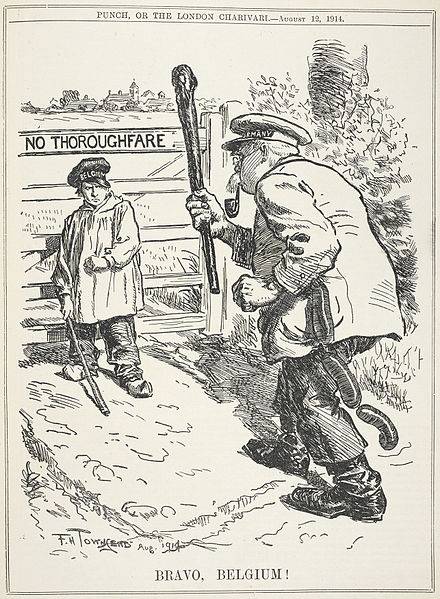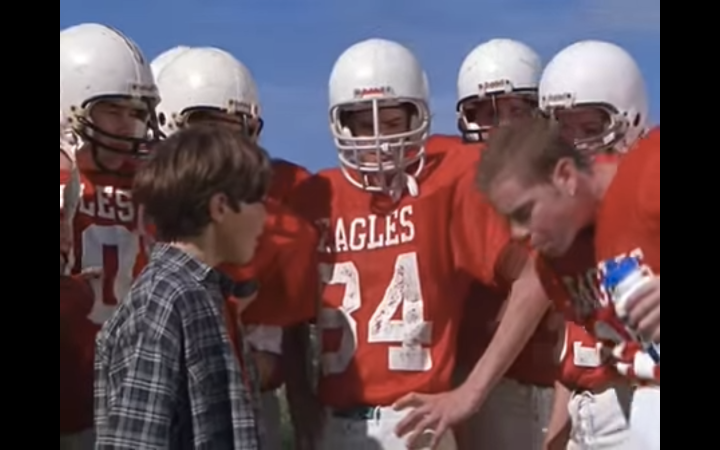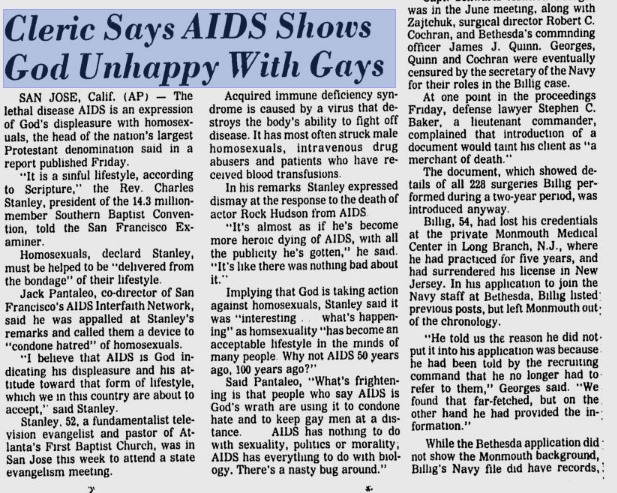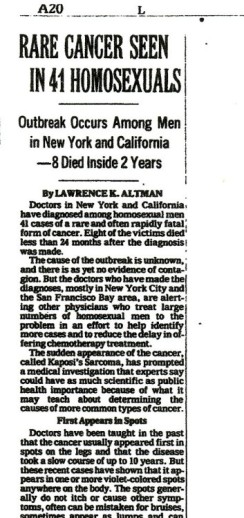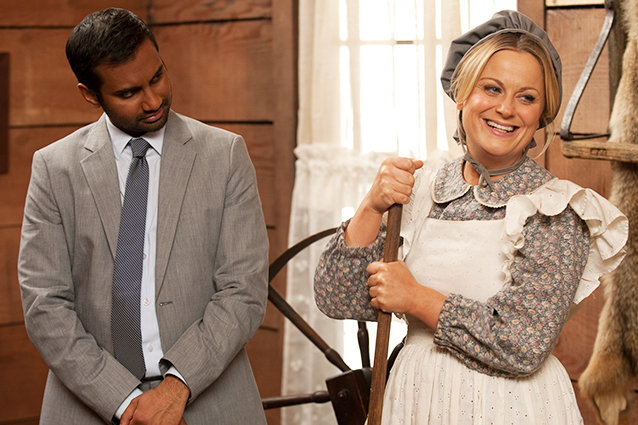Overview
Propaganda can be defined as the systematic propagation of information or ideas by an interested party in order to encourage or instill a particular attitude or response in an audience. The ideas and doctrines thus disseminated are also referred to as “propaganda.” There is no more blatant an example of this concept than wartime propaganda, in which the homeland is typically praised and uplifted and, the enemy, demonized.
Demonization consists of the portrayal of an enemy or party with opposing viewpoints as excessively cruel, threatening, and inhumane. In his 1927 post-World War I book, Propaganda Techniques in the World War, Communication theorist Harold Lasswell wrote the following on demonization of the enemy in wartime propaganda:
“So great are the psychological resistances to war in modern nations that every war must appear to be a war of defence against a menacing, murderous aggressor. There must be no ambiguity about whom the public is to hate. […] Guilt and guilelessness must be assessed geographically, and all the guilt must be on the other side of the frontier.”[1]
A marked example of enemy demonization in U.S. wartime propaganda history comes in the form of American anti-Japanese propaganda during World War II. On December 7, 1941, years of economic tensions between the Empire of Japan and the United States culminated in a devastating attack by the Japanese navy on the American naval base at Pearl Harbor on Oahu Island, Hawaii. Over 2,000 American soldiers and sailors lost their lives, and more than 1,000 were wounded. 20 American naval vessels, including eight major battleships, were destroyed along with over 180 aircrafts. The very next day, the United States declared war on Japan.[2]
During the war, American mass media – newspapers, radio, film, and music – was ridden with war propaganda, glorifying those fighting for the country while depicting its enemies to the public as monstrous, inhuman, and savage. In the American public eye, the Japanese thus quickly rose in the ranks of ugliness and perceived threat as an opponent that had to be destroyed at all costs. America had been betrayed, and would now set things straight.
Core Concepts
American anti-Japanese propaganda focused on highlighting the foreign-ness of the Japanese enemy, emphasizing and mocking the latter’s physical characteristics, culture, and beliefs. In his 2001 paper, “Anti-Japanese Musical Propaganda in World War II Hollywood,” W. Anthony Sheppard, a professor of music at Williams College, notes that, in much of American anti-Japanese propaganda, the Japanese were derogatively referred to as “Japs” and depicted as violent apes or some form of vermin, referred to as “sneaky little yellow rats.”[3] According to Ithaca College professors Nancy Brcak and John R. Pavia’s paper, “Racism in Japanese and U.S. Wartime Propaganda,” in U.S. propaganda, the Japanese custom of respecting authority was demonstrated by American propaganda as a form of fanaticism, and Japanese immigrants in the United States were also labeled as people not to be trusted.
The American public was constantly reminded of the Pearl Harbor attacks, of the way the Japanese treated their prisoners of war, and the war atrocities they committed.[4] In propaganda posters, Brcak and Pavia write, common tropes included depicting the Japanese as monstrous apes threatening the honor of the United States and/or a white American woman. The words “sneaky,” “monster,” and “Japs” were painted in big, bold lettering. A cruiser called Honolulu is remembered to have had a sign on its bow that read, “Kill Japs. Kill Japs Kill More Japs.” Admiral William Frederick Halsey of the U.S. Navy is quoted as having publicly spoken of the Japanese as “bestial apes” and saying, “We are drowning and burning [them] all over the Pacific, and it is just as much pleasure to burn them as to drown them.”[5]
Devices used in American anti-Japanese songs and film included ridiculing the Japanese accent when speaking English, rhyming the derogatory term “Japs” with as many negative English words as possible, and drawing on stereotypical racist images for the depiction of Japanese people, including yellow-toned skin, round wire glasses, slanted eyes, wispy mustaches, and buck teeth. There were constant reminders of the Pearl Harbor attack, as well as war atrocities that the Japanese were said to have committed. In the rare occasions where U.S. propaganda referred to traditional Japanese music itself, the works were presented as an example of Japanese “fanaticism” and a highlight of the foreign-ness and otherness of the Japanese culture.[6] What follows is a closer look at American anti-Japanese wartime propaganda posters, music, and film.
Examples
Posters
Propaganda posters focused on monstrously emphasizing the foreign qualities of the Japanese, especially their physical characteristics, in a negative way. Derogatory terms such as “Japs,” “enemy,” “monster,” and “sneaky” accompanied these images of cruel demon-like creatures. The American public was constantly reminded of the Japanese alliance with the German Nazis, told atrocity stories of how Japanese officers tortured and killed American prisoners of war, and called to action in the name of patriotism and protection of homeland honor – this honor usually depicted as a white American woman in distress.

This poster consists of a call to action for American citizens to continue their support of the war from home. Anyone who was not openly risking their life in the battlefield overseas had the civic responsibility of helping support the war. The call to action is supplemented with the image of an ugly, evil-looking, presumably Japanese soldier beating a Western man with the back of a rifle, along with what seems to be a newspaper headline describing Japanese war atrocities in their prisoner camps. The background of the image depicts what seems to be the “death march” spoken of in the newspaper clipping, and the derogatory term “Jap” is used both in the newspaper clipping image and the slogan. The poster implies that every one of these “Japs” is a murderer that needs to be “wiped out.”

This poster contains an ape-like creature wearing the Japanese military uniform and cap depicting the iconic “rising sun” of the Japanese flag. The creature has long, claw-like fingernails and is brandishing a knife aimed toward the back of a terrified Western woman. The creature is obviously a Japanese soldier, with stereotypical Japanese facial features grossly exaggerated and supplemented with a bestial expression and demonically long and sharp fingernails. The image evokes not only the “backstabbing” of the United States by Japan that occurred with the Pear Harbor attacks, but also the representation of the woman as the American every-woman, or even as the U.S. itself. The enemy, then, is not only stabbing the country in the back, but also threatening its honor, the way the ape in the poster is doing to the woman.
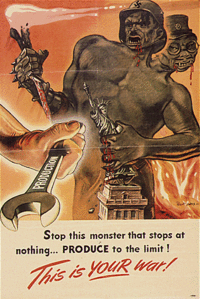
This poster depicts another call to action for citizens in the homeland to continue their support of the war. A beast with two heads and mouths dripping blood is shown towering over a burning landscape. The left head of the beast sports a German military hat with the Nazi swastika on its front and has facial features reminiscent of Nazi leader Adolf Hitler’s (see the iconic mustache, thick brows, and side fringe). The right head of the beast is round and rat-like, sporting a Japanese military cap and stereotypical round glasses over slanted, squinting eyes, a stereotypical wispy mustache, and buck teeth. The beast brandishes a bloody knife on one hand and the Statue of Liberty on the other. This beast is a representation of the allied Germany and Japan, and is depicted to be disgracing the very core of American patriotic imagery: the Statue of Liberty itself and the very value of freedom that the country was built upon. To the left of the poster, a hand holds a large wrench labeled “production” as if poised to strike a blow. This image, along with the slogan, evokes the sentiment that production of war supplies is the main weapon for Americans at home to fight against their country’s bestial enemy. Americans are reminded that the entire country is fighting the war, and not just the soldiers abroad.
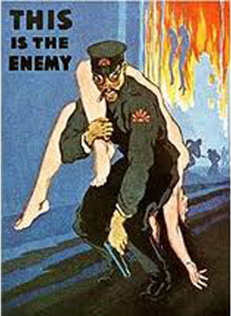
This poster depicts another, even stronger image of a threat to female honor. What is clearly a Japanese soldier, but with demonic and rat-like facial features and the stereotypical round glasses and wispy mustache, seems to be stealthily leaving a battlefield in the background with a naked, Western woman slung over his shoulder. There is the implication that the soldier is about to rape this woman, and is stealing away from the battlefield to do so – two unforgivable actions. The slogan reads, “This is the enemy,” implying that the Japanese enemy is demon-like, cunning, disloyal, and a threat to the honor of both the American woman and America itself.
Music
Music played a massive role in wartime propaganda. One of the most enduring Pearl Harbor songs, “Remember Pearl Harbor,” was written by Don Reid and Sammy Kaye, and recorded by American bandleader and vocalist Eddy Howard. The following is an excerpt of the lyrics, as found in Kathleen E. R. Smith’s 2003 book, God Bless America: Tin Pan Alley Goes to War:
Let’s REMEMBER PEARL HARBOR
As we go to meet the foe.
Let’s REMEMBER PEARL HARBOR
As we did the Alamo.
We will always remember
How they died for liberty.
Let’s REMEMBER PEARL HARBOR
And go on to victory.[7]
Sheppard notes in his work that popular, more overtly racist titles included the following:
“We’re Gonna Have to Slap the Dirty Little Jap”
“Taps for Japs”
“We’ll Nip the Nipponese”
“We’re Gonna Change the Map of the Jap”
“We’re Gonna Play the Yankee Doodle in Tokyo”
“You’re a Sap, Mister Jap”[8]
The following is an excerpt from another popular song, “Goodbye Mama (I’m off to Yokohama),” written and composed by Fred J. Coots ten days after the Pearl Harbor attack:
Goodbye, Mamma,
I’m off to Yokohama,
For my red, white and blue,
My country and you.
Goodbye, Mamma,
I’m off to Yokohama,
Just to teach all those Japs,
That the Yanks are no Saps.
A million fightin’ sons of Uncle Sam,
if you please,
Will soon have all those Japs right down,
on their Jap-a-knees.[9]
The 1944 song “A-Bombing We Will Go (Right over Tokio)” by Lu Earl featured the following lines:
Look out, you yellow Japs
You thought that we were saps,
We’re gonna blast you away up high.
Now you bombed Pearl Harbor in your mean and sneaky way,
So we’re gonna jar your little island night and day.[10]
Note the repeated remembrance of Pearl Harbor and the usage of racist derogatory terms such as “Nipponese,” “Jap,” and “yellow.” Furthermore, this was all underlined by a sense of patriotism and duty towards one’s country and honor.
Film
Film was an extremely popular medium of entertainment during the 1940s, and was thus used for the purpose of wartime propaganda. Newsreels regarding the progress of the war and calls for contributions of scrap metal for the war effort and purchase of war bonds, along with other relevant announcements, would precede the film itself. Sheppard notes that around 25 anti-Japanese films were released in the United States in 1942 alone.[11] In these films, the Japanese would usually be depicted in the form of a plane in the sky, a ship in the horizon, or a mass of anonymous infantrymen, all approaching with danger-evoking music in the background. Individual Japanese soldiers were depicted as sadists who delighted in torturing American prisoners. The racist propaganda in these productions was accomplished through both the depictions of the Japanese characters’ villainy and extensive dialogue about it, as well as the repeated use of derogatory terms such as “Japs,” “yellow,” and “rats” to describe the Japanese people, all for the purpose of dehumanizing the group and cutting off any possibility of empathy in the American mind.[12]
Another strategy used in these films came in the form of motivating troops to fight by showing them footage from confiscated Japanese films[13], wrote American historian John W. Dower in his 1986 book, War Without Mercy (see PDF here). When the United States became involved in World War II, U.S. Army Chief of Staff George C. Marshall enlisted Hollywood director Frank Capra to prepare orientation films for new troops.[14] One of Capra’s focuses was to stress the importance of the war effort. To do this, Dower writes, Capra engaged in not only demonizing the enemy, but also depicting the enemy demonizing the Americans. The historian writes that Capra expressed, “Let the enemy prove to our soldiers the enormity of his cause – and the justness of ours. […] Let our boys hear the Nazis and the Japs shout their own claims of master-race crud, and our fighting men with know why they are in uniform.”[15] Capra thus collected as much enemy propaganda footage as possible and incorporated it into his own films, juxtaposing the enemy footage with American messages of encouragement.[16]
In his 2011 article in the Journal of American Ethic and History, “Superman Goes to War: Teaching Japanese American Exile and Incarceration,” College Misericordia History professor Allan W. Austin explains that U.S. World War II propaganda films always reminded the public that the Japanese were the ones who started the war, and the United States was responding to their betrayal. In the 1944 production The Purple Heart, directed by Lewis Milestone, American troop captain Harvey Ross (played by Dana Andrews) is depicted arguing in a Japanese court, saying, “You wanted it, you asked for it, you started it! And now you’re going to get it, and it won’t be finished until your dirty little empire is wiped off the face of the earth.”[17] The image of Japanese immigrants in the United States as being treacherous was also common in film as well. In The Purple Heart, a Japanese chief of army intelligence reveals that he had lived in California in the 1930s and spied on the United States. The 1942 film Little Tokyo, U.S.A. emphasized the idea that Japanese Americans posed a threat because “anyone of Japanese descent, whether alien or American citizen, was loyal to the emperor of Japan and a potential traitor to America.”[18]
Popular characters in media such as Superman and Dr. Seuss were also added to aid anti-Japanese propaganda. In a 1943 Superman cartoon called Japoteurs (which you can watch here), an exaggeratedly stereotypical Japanese man – featuring thick glasses, buck teeth, and extremely heavy accent – living in the United States is demonstrated feigning loyalty to the country by day, with a picture of the Statue of Liberty hung in his office, and engaging in treachery in the dark, when that picture is replaced by a portrait of the rising sun, to which the man bows deeply as ominous music plays in the background. The Japanese man turns out to be a traitor (obviously) and threatens not only the safety of the country but the honor of a white American woman as well. Naturally, Superman arrives just in time to save both the country and the damsel in distress.[19]


These screenshots from Japoteurs [20] depict the scene in which the Japanese-American man’s betrayal is revealed. He keeps a picture of the Statue of Liberty hung in his office by day but, when night comes, he closes the blinds and changes the picture to one of the iconic Japanese rising sun, to which he bows deeply, signaling the customary Japanese respect to authoritative figures and symbols that was stereotyped in the West as fanaticism.
Theodor Seuss Geisel, popularly known by his pen name, “Dr. Seuss,” was a widely popular American children’s book author, with renowned titles including “Green Eggs and Ham” and “The Cat in the Hat.”[21] Geisel was the Chief Editorial Cartoonist for the New York-based newspaper PM during World War II, and he himself supported the American war effort and engaged in anti-Japanese cartoon propaganda without reservation.[22] Richard Minear, a retired professor of History at the University of Massachusetts at Amherst contributes to University of California at San Diego’s website Dr. Seuss Went to War, which catalogs Geisel’s political cartoons during World War II (click here to visit the site). The following images are some of the many compiled in the site:


Propaganda was also present in magazine covers. A striking example and embodiment of demonization is the following cover of Collier’s magazine in its December 1942 edition:[25]
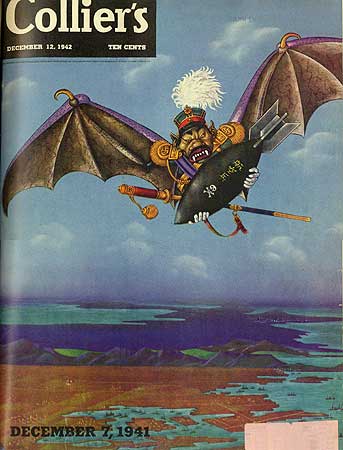
This picture, drawn by Arthur Szyk, depicts a demon with a bomb flying over what presumably (note the date at the bottom left corner of the image) is Pearl Harbor. The demon not only features Japanese-looking garments, but is also decorated with Nazi swastikas.
Conclusion
In the form of colorful, grotesquely memorable images in print, television, and film, and catchy, patriotic lyrics in music, American anti-Japanese propaganda successfully steered the sentiments of the U.S. population toward the hatred for the Japanese and the continuation of support towards the war effort. Japanese immigrants in the United States, as well as Japanese-Americans, were automatically suspected of being spies and put into internment camps. Viewing American action as retaliation for the betrayal of Pearl Harbor, Americans fought against Japan until the latter surrendered in late 1945, after the United States dropped two atomic bombs on Hiroshima and Nagasaki.[26] World War II ended with approximately 418,500 military and civilian deaths for the United States, and around 2,600,000 to 3,100,000 for Japan.[27]
In the present day, we must keep in mind that, when confronted with emotionally charged imagery and wording, it is important to take a step back and assess what kind of reaction the material is attempting to elicit from the audience. In a globalized and technologically advanced society, where fake content posing as real news is strategically circulated in mass media, it is vital to research the truth behind the claims in political imagery and never take things at face value. Last, but definitely not least, demonization is never the answer to political or social problems. There is a big difference between simply fueling ignorant stereotypes and hatred against a threatening group and actually providing audiences with verifiable facts and reasonable calls to action.
In Michelle Obama’s words: “When they go low, we go high.”
Discussion Questions
- Why is it so important to highlight the otherness of an enemy in demonization propaganda?
- Why is the specific image of the ape used in demonization propaganda?
- Why is the image of the damsel in distress so often used in propaganda?
- What effect might this type of propaganda have on a contemporary American audience?
More Information:
- War Without Mercy by John W. Dower (1986, Pantheon Books) [PDF here]
- Encyclopedia Britannica: Pearl Harbor Attack (http://www.history.com/topics/world-war-ii/pearl-harbor)
- Hiroshima and Nagasaki atomic bombings and the Japanese surrender: (https://www.ushmm.org/wlc/en/article.php?ModuleId=10005155)
- “Anti-Japanese Musical Propaganda in World War II Hollywood” by W. Anthony Sheppard in the Journal of the American Musicological Society, Edition 54 Volume 2, pages 303-357
- “Racism in Japanese and U.S. Wartime Propaganda” by Nancy Brcak and John R. Pavia in the journal Historian, Edition 56 Volume 4, pages 671 – 684
- God Bless America: Tin Pan Alley Goes to War, by Kathleen E. R. Smith, 2003.
- The National WWII Museum in New Orleans website: http://www.nationalww2museum.org/learn/education/for-students/ww2-history/
- Seuss Went to War a compilation of Dr. Seuss’s political cartoons: http://library.ucsd.edu/speccoll/dswenttowar/index.html
Footnotes
[1] Lasswell, H. (1938). Chapter 3: War Guilt and War Aims. Propaganda Techniques in the World War. 47-76. Web: https://archive.org/details/PropagandaTechniqueInTheWorldWar
[2] From Encyclopedia Britannica: Pearl Harbor Attack: Japanese-United States history. Retrieved from: https://www.britannica.com/event/Pearl-Harbor-attack
[3] Sheppard, W. (2001). Anti-Japanese Musical Propaganda in World War II Hollywood. Journal of the American Musicological Society, 54(2), 303-357. Retrieved from http://www.jstor.org/stable/10.1525/jams.2001.54.2.303
[4] Brcak, N., Pavia, J. (1994). Racism in Japanese and U.S. wartime propaganda. Historian, 56(4), 671 – 684. Retrieved from http://eds.b.ebscohost.com/eds/pdfviewer/pdfviewer?sid=a68ac817-6478-423d-b598-5a2e66bec407%40sessionmgr106&vid=2&hid=120
[5] Brcak & Pavia, p. 674
[6] Sheppard, p. 305
[7] Smith, K. (2003). God Bless America: Tin Pan Alley Goes to War. p. 14.
[8] Sheppard, p. 306
[9] Smith, p. 14
[10] Sheppard, p. 306
[11] Sheppard, p. 307
[12] Sheppard, p. 307
[13] John W. Dower, War Without Mercy (1986). Retrieved from https://docs.google.com/file/d/0B-5-JeCa2Z7hMllVU29Vc21PLVk/edit?pli=1. p. 16
[14] Dower, 15
[15] Dower, 16
[16] Dower, 16
[17] Austin, A. (2011). Superman Goes to War: Teaching Japanese American Exile and Incarceration with Film. Journal of American Ethnic History, 30(4). 51-56, Retrieved from http://eds.a.ebscohost.com/eds/pdfviewer/pdfviewer?sid=5000c738-67d8-4cd2-8494-4fcda605549d%40sessionmgr4007&vid=2&hid=4211
[18] Austin, p. 54
[19] Austin, p. 54
[20] Full video here: https://www.youtube.com/watch?v=0E0ss_jeAeg
[21] Biography.com – Dr. Seuss: http://www.biography.com/people/dr-seuss-9479638#synopsis
[22] Minear, R. (2012). Introduction. In Dr. Seuss Went to War. Retrieved from http://library.ucsd.edu/speccoll/dswenttowar/index.html
[23]Minear, R. (2012). In Dr. Seuss Went to War. Retrieved from http://library.ucsd.edu/speccoll/dswenttowar/index.html#ark:bb6792686z
[24] Minear, R. (2012). In Dr. Seuss Went to War. Retrieved from http://library.ucsd.edu/speccoll/dswenttowar/index.html#ark:bb3618599q
[25] Brcak & Pavia, p. 682
[26] United States Holocaust Museum: World War II in the Pacific – https://www.ushmm.org/wlc/en/article.php?ModuleId=10005155
[27] By the Numbers: World Wide Deaths. In The National WWII Museum. Retrieved from http://www.nationalww2museum.org/learn/education/for-students/ww2-history/ww2-by-the-numbers/world-wide-deaths.html?referrer=https://www.google.com/










